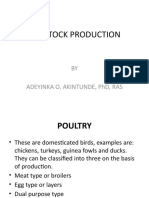V. Steps/Procedures:: May Harvest 300-500 Fry Per Spawning Possible To Spawn Weekly
V. Steps/Procedures:: May Harvest 300-500 Fry Per Spawning Possible To Spawn Weekly
Uploaded by
Fibo AdhityaCopyright:
Available Formats
V. Steps/Procedures:: May Harvest 300-500 Fry Per Spawning Possible To Spawn Weekly
V. Steps/Procedures:: May Harvest 300-500 Fry Per Spawning Possible To Spawn Weekly
Uploaded by
Fibo AdhityaOriginal Title
Copyright
Available Formats
Share this document
Did you find this document useful?
Is this content inappropriate?
Copyright:
Available Formats
V. Steps/Procedures:: May Harvest 300-500 Fry Per Spawning Possible To Spawn Weekly
V. Steps/Procedures:: May Harvest 300-500 Fry Per Spawning Possible To Spawn Weekly
Uploaded by
Fibo AdhityaCopyright:
Available Formats
V.
Steps/Procedures:
1. Set up 2 aquaria
• Place the egg-collector diagonally to
ensure sticking of the adhesive
eggs. (egg-collectors must be long
enough to reach the other side of
aquarium)
• Place aeration (Aeration must be very gentle)
2. Place a pair of breeders on the prepared aquarium.
(Angelfish are monogamous therefore proper identification of
pair is a must to ensure optimum reproduction.
3. Remove the egg-collector after fertilization and place it on the
other one. Observe proper handling of
eggs. Aeration of eggs must be very
gentle to ensure hatching. Eggs are
treated with hydrogen peroxide. (two
days after spawning).
4. Feed the larvae with artemia starting on the fifth day after
spawning until two weeks. Feeding
is once a day. Thereafter, artificial
feeds will be introduced.
5. Let the set-up stand for 3 weeks.
6. After 3 weeks, transfer the fry to grow-
out tank/hapa or pond
MAY HARVEST 300- 500 FRY PER SPAWNING
POSSIBLE TO SPAWN WEEKLY
NATIONAL INTEGRATED FISHERIES TECHNOLOGY DEVELOPMENT CENTER
Para sa karagdagang kaalaman, sumangguni sa: Bureau of Fisheries and Aquatic Resources
Bureau of Fisheries and Aquatic Resources Department of Agriculture
NATIONAL INTEGRATED FISHERIES TECHNOLOGY DEVELOPMENT CENTER Tel. No. (075) 653-5412; Telefax No.: (075) 653-0385
Bonuan-Binloc, Dagupan City, Philippines E-mail : bfarniftdc@yahoo.com
Tel. No.: (075) 653-5412; Telefax No.: 653-0385
E-mail:bfarniftdc@yahoo.com;westlyrosario@ymail.com Published by the ASIAN FISHERIES ACADEMY
Facebook & twitter account: aquatechdocwestly@yahoo.com E-mail : asianfishacademy@yahoo.com
Tel. No. (075) 653-8851
Sexing Angelfish
I. Male/Female Characteristics:
Male
• usually big in size
• head is partially bent
General Description of an Angelfish • breeding tubes or genital papillae is smaller and carried at
an angle closer to vertical
• the shape is very atypical of the cichlide pattern, being • the sides of mature males appear quiet flat
depressed laterally to form an almost circular disc
• the dorsal and anal fins are elongated and point backwards Female
• the tail fin is lyre-shaped with extremely elongated angles and • smaller in size
the rays of the pelvic fins show extreme lengthening • smooth curve of head
• the silver grey body is traversed by dark bars, the most • vent is said to be more prominent
posterior of which extends into the dorsal and anal fins • breeding tubes or genital papillae is largers and projects
• the second is midway along the body while a third passes slightly backwards
through the eye • genital papillae is larger and more blunt
• the base of the tail fin is also marked by a dark bar • slight abdominal bulge or thicker in body
• grows up to 6 in. long and 8 in. deep.
• can reach up to 3-5 years in good condition II. Maturation/Spawning Age
• spawning is whole-year round
Four species of angelfish: • best age for pairing and spawning is when the angels are a
1. Pterophyllum eimekei year old.
2. Pterophyllum scalare • after 7-18 days of spawning, angelfish will eminently spawn
3. Pterophyllum altum again
4. Pterophyllum leopoldi • 500-1,000 eggs are laid per spawning
• an 80% hatching and survival rate is normally attained
Breeders Selection: III. Characteristics of Breeders About to Spawn:
• Appearance of genital papillae
Look for strong, robust and active fish/feeders with long healthy • both male and female’s papilla is in protruding condition
fins and good contrast in colors. Avoid individuals with abnormal • 2-3 days before spawning, the pair selects and clean the
operculum/gill covers. spawning site, using their mouths until satisfied
3 ways to obtain a breeding pair of angels IV. Breeding Facilities/Equipment Needed:
• buy a pair which already spawned and produced fertile eggs • 2 aquaria about 15 gallons capacity
• buy a number of angels and wait for them to pair off • scoop net
• attempt to select a pair from a number of large angels, using • aerator
own judgement in sexing them • egg collector (strips of slates, clay, glass tubes, etc.)
You might also like
- Pig Tales: An Omnivores Quest For Sustainable MeatDocument4 pagesPig Tales: An Omnivores Quest For Sustainable Meatwamu885No ratings yet
- Food Chains 5-6 Focus Book JurassicfoodchainsDocument6 pagesFood Chains 5-6 Focus Book JurassicfoodchainsFelipe R.0% (1)
- Background To Pig Production in FijiDocument58 pagesBackground To Pig Production in FijiManoa Nagatalevu Tupou91% (11)
- Goat Farming GuideDocument15 pagesGoat Farming GuideGrowel Agrovet Private Limited.100% (5)
- Reproductive Biology of CatfishDocument26 pagesReproductive Biology of CatfishRommel Corpuz100% (2)
- Chap 4 Fish ReproductionDocument48 pagesChap 4 Fish Reproductionamare mitkuNo ratings yet
- Reproduction: Types of FertilisationDocument2 pagesReproduction: Types of FertilisationKateNo ratings yet
- Lec 4 - Fish BreedingDocument3 pagesLec 4 - Fish BreedingDominic LuceroNo ratings yet
- Lesson 6.3 The Reproduction of AnimalsDocument38 pagesLesson 6.3 The Reproduction of Animalsgwynangelsaturgo07No ratings yet
- III.B. The Reproduction of AnimalsDocument22 pagesIII.B. The Reproduction of AnimalsDarwin NoolNo ratings yet
- GuppiesDocument63 pagesGuppiesEduard Ayala GarciaNo ratings yet
- MTJ Raise Organic Hogs - ElectiveDocument164 pagesMTJ Raise Organic Hogs - ElectiveMarvin RiveroNo ratings yet
- Lizards - ReproductionDocument15 pagesLizards - ReproductionMihika KhadeNo ratings yet
- Notes-GOAT PRODUCTION New SylbusDocument10 pagesNotes-GOAT PRODUCTION New SylbusMompoloki Bluda GabathusiNo ratings yet
- Q2 Lesson 3 Reproduction in AnimalsDocument38 pagesQ2 Lesson 3 Reproduction in AnimalsGilda OcampoNo ratings yet
- Life Cycle of The Honey BeeDocument30 pagesLife Cycle of The Honey Beeymanisha670No ratings yet
- Introduction To ReproductionDocument45 pagesIntroduction To ReproductionCharmaine Fernandez100% (1)
- Ornamental Breeding ConceptsDocument83 pagesOrnamental Breeding ConceptsjoshigautaNo ratings yet
- Artificial InseminationDocument8 pagesArtificial InseminationSagar HanamasagarNo ratings yet
- Reproductive Strategies in VertebratesDocument5 pagesReproductive Strategies in VertebratesMcKay MwewaNo ratings yet
- Biology Mammals PPT Kel.10Document46 pagesBiology Mammals PPT Kel.10Indah BarizahhNo ratings yet
- Screenshot 2023-09-27 at 9.37.48 PMDocument17 pagesScreenshot 2023-09-27 at 9.37.48 PMswvqg5hyzmNo ratings yet
- JDC Biology of Some Aquarium Fishes - 050426Document13 pagesJDC Biology of Some Aquarium Fishes - 050426nasrin4329.nkNo ratings yet
- Chicken Embryo DevelopmentDocument35 pagesChicken Embryo DevelopmentJennifer CeladesNo ratings yet
- P5 Sci NotesDocument139 pagesP5 Sci NotesmuhwezirulangiragodfreyNo ratings yet
- Swine PPT 2012Document99 pagesSwine PPT 2012ዘንገና ቲዩብNo ratings yet
- Mechanical Vectors of Medical ImportanceDocument35 pagesMechanical Vectors of Medical ImportanceCLEMENTNo ratings yet
- Induced BreedingDocument29 pagesInduced BreedingAyesha MalikNo ratings yet
- Parental Care in FishDocument6 pagesParental Care in FishRaghu ChawhanNo ratings yet
- Sexual Reproduction in AnimalsDocument250 pagesSexual Reproduction in Animalsstephenkaran073No ratings yet
- Doodle World Wildlife Day Infographics by SlidesgoDocument13 pagesDoodle World Wildlife Day Infographics by Slidesgokouassi.marieNo ratings yet
- Embryology Overview StudentsDocument20 pagesEmbryology Overview StudentsEloisa Marie Enriquez BontilaoNo ratings yet
- Reproduksi HewanDocument92 pagesReproduksi Hewanizkaremie100% (3)
- Sustainable Village Chicken ProductionDocument35 pagesSustainable Village Chicken Productionbwalyadavid820No ratings yet
- Pig FarmingDocument37 pagesPig FarmingNurul NajwaNo ratings yet
- Invertebrados 4Document60 pagesInvertebrados 4reyes.sammyNo ratings yet
- Unit 5 Fish Breeding: A. Brood Fish ManagementDocument16 pagesUnit 5 Fish Breeding: A. Brood Fish ManagementNabin SinghNo ratings yet
- Milkfish HatcheryDocument37 pagesMilkfish HatcheryYeng Cate100% (1)
- Vertebrates-1 ESODocument52 pagesVertebrates-1 ESOHelena SaorinNo ratings yet
- Unit-3 Artificial InseminationDocument44 pagesUnit-3 Artificial Inseminationfactssmile4No ratings yet
- ADITY - SARBAJNABiology of Aquarium Fishes Lecture 22020-04-29biology of Aquarium Fishes Lec 2Document5 pagesADITY - SARBAJNABiology of Aquarium Fishes Lecture 22020-04-29biology of Aquarium Fishes Lec 2DaḿilareNo ratings yet
- How Representative Animals ReproduceDocument29 pagesHow Representative Animals ReproduceIMY PAMEROYANNo ratings yet
- Torsion in MolluscaDocument65 pagesTorsion in MolluscamicrokannanNo ratings yet
- CH 1 IIDocument29 pagesCH 1 IIViraat SinghNo ratings yet
- Animal Kingdom-2 PDFDocument36 pagesAnimal Kingdom-2 PDFANo ratings yet
- VertebratesDocument22 pagesVertebratesAnasNo ratings yet
- Viii 11Document49 pagesViii 11jallmero87No ratings yet
- Aquaculture NotesDocument9 pagesAquaculture NotesHannah Lois VecinoNo ratings yet
- 12 Chicken ProductionDocument29 pages12 Chicken ProductionMcangels bandaNo ratings yet
- Nematodes LabDocument13 pagesNematodes LabCenonina Paola TapiaNo ratings yet
- Guide To Snail Breeding and CullingDocument7 pagesGuide To Snail Breeding and Cullingcatemoji 333No ratings yet
- Seahorses Male and FemaleDocument1 pageSeahorses Male and FemaleirenegannonNo ratings yet
- REPRODUCTION IN VERTEBRATES Notes 2024Document7 pagesREPRODUCTION IN VERTEBRATES Notes 2024keaninhendricks14No ratings yet
- Reproduction in VertebratesDocument13 pagesReproduction in Vertebrateskeiradutoit6No ratings yet
- BreedingDocument30 pagesBreedingvaldezedralinmaeNo ratings yet
- Livestock Production: BY Adeyinka O. Akintunde, PHD, RasDocument34 pagesLivestock Production: BY Adeyinka O. Akintunde, PHD, RasNonny ElewekeNo ratings yet
- 8th Class Chapter 9Document22 pages8th Class Chapter 9fearof007No ratings yet
- Modes of Reproduction in Animals - ZeeshanDocument18 pagesModes of Reproduction in Animals - Zeeshanrealynsuma057No ratings yet
- Scorpions For Kids: Amazing Animal Books For Young ReadersFrom EverandScorpions For Kids: Amazing Animal Books For Young ReadersRating: 1 out of 5 stars1/5 (1)
- Key For Family Identification of SpidersDocument5 pagesKey For Family Identification of SpidersMuhammad HussnainNo ratings yet
- Lat - Main Idea 18Document1 pageLat - Main Idea 18Joel PanggabeanNo ratings yet
- Insects Escaping The Earth by Peter Fraser Reading ExtractDocument9 pagesInsects Escaping The Earth by Peter Fraser Reading ExtractPavNo ratings yet
- GeetaDocument8 pagesGeetakadapa22No ratings yet
- Ecological Adaptations PracticalsDocument24 pagesEcological Adaptations PracticalsMariyam SiddiqaNo ratings yet
- Bhagwan Birsa 201617Document40 pagesBhagwan Birsa 201617prasadnitesh2543No ratings yet
- Classification of Invertebrates and Vertebrates (With Answer)Document2 pagesClassification of Invertebrates and Vertebrates (With Answer)Hui Sia WongNo ratings yet
- Taenia SoliumDocument40 pagesTaenia SoliumBio SciencesNo ratings yet
- T SC 124 Hibernation PowerPoint - Ver - 3Document13 pagesT SC 124 Hibernation PowerPoint - Ver - 3Kadek KusumaNo ratings yet
- Why Are So Few Tigers Man-EatersDocument6 pagesWhy Are So Few Tigers Man-EatersTuệ Tâm NguyễnNo ratings yet
- PTS BIG GENAP 2022 - Google FormulirDocument14 pagesPTS BIG GENAP 2022 - Google FormulirHeru Dwi SetiawanNo ratings yet
- Jurnal 1 - Saccus PneumaticusDocument7 pagesJurnal 1 - Saccus PneumaticusZayyan MuafiNo ratings yet
- Animal Word ScrambleDocument4 pagesAnimal Word ScramblepzahNo ratings yet
- Phylum Arthropoda With Lab WorksheetDocument6 pagesPhylum Arthropoda With Lab WorksheetMi RiveraNo ratings yet
- Lesson Plan in English 6: I. ObjectivesDocument4 pagesLesson Plan in English 6: I. ObjectivesjennibethNo ratings yet
- Extraordinary EarthwormsDocument7 pagesExtraordinary EarthwormsGustavoNo ratings yet
- Study of Birds in Unprotected Grassland Patches of South Solapur, District Solapur, Maharashtra State, IndiaDocument10 pagesStudy of Birds in Unprotected Grassland Patches of South Solapur, District Solapur, Maharashtra State, IndiaBalasaheb LambtureNo ratings yet
- RagunanDocument7 pagesRagunanIda Bagus Alit ManuabaNo ratings yet
- Build A Glossary With The Next Words (Follow The Example Given)Document15 pagesBuild A Glossary With The Next Words (Follow The Example Given)Laura RuizNo ratings yet
- Zoo 211 (2018 - 2019) Past QuestionDocument3 pagesZoo 211 (2018 - 2019) Past Questionmusanafisat593No ratings yet
- Animals Living and Surviving CBSE Class 4 WorksheetDocument4 pagesAnimals Living and Surviving CBSE Class 4 WorksheetLucky250388% (8)
- (P2 Esei) Compare Between Fish and HumanDocument2 pages(P2 Esei) Compare Between Fish and HumanKar Ru100% (3)
- Assembled by Lee Eberly: Accipiter, A Member of The Genus Accipiter The "Short-WingedDocument10 pagesAssembled by Lee Eberly: Accipiter, A Member of The Genus Accipiter The "Short-WingedAn DraoidhNo ratings yet
- Worksheet Living and Non-Living Things Worksheet - QuizizzDocument6 pagesWorksheet Living and Non-Living Things Worksheet - QuizizzScience TeacherNo ratings yet
- FishesDocument1 pageFishesjenicarevillozaNo ratings yet
- Unit 5Document12 pagesUnit 5wiladaNo ratings yet
- 9 Desert AnimalsDocument2 pages9 Desert AnimalsArchanaNo ratings yet
- Read Through The Text. Design A Food Web and Answer Some Questions From The Following InformationDocument6 pagesRead Through The Text. Design A Food Web and Answer Some Questions From The Following InformationAzalia Delgado VeraNo ratings yet

























































































